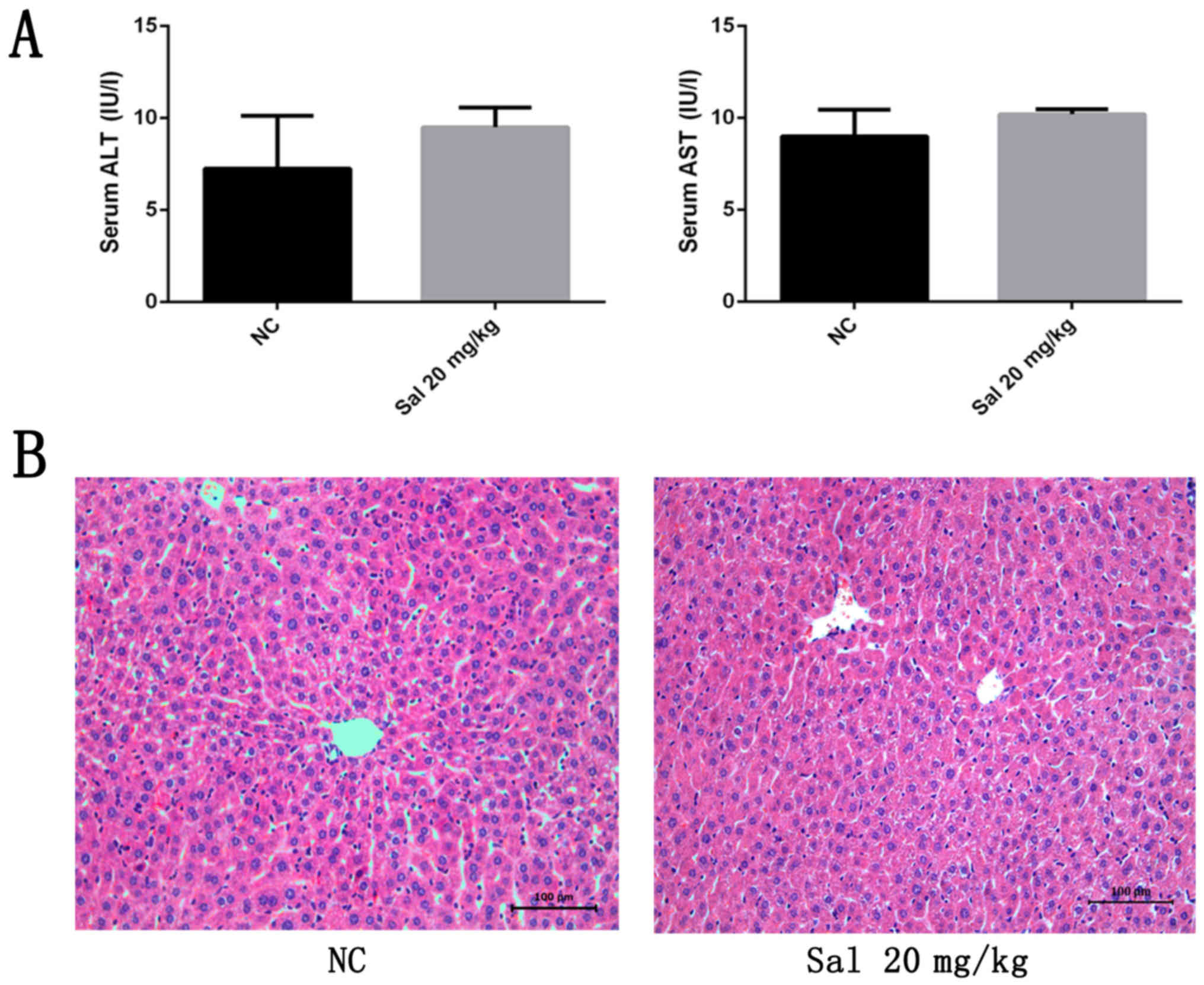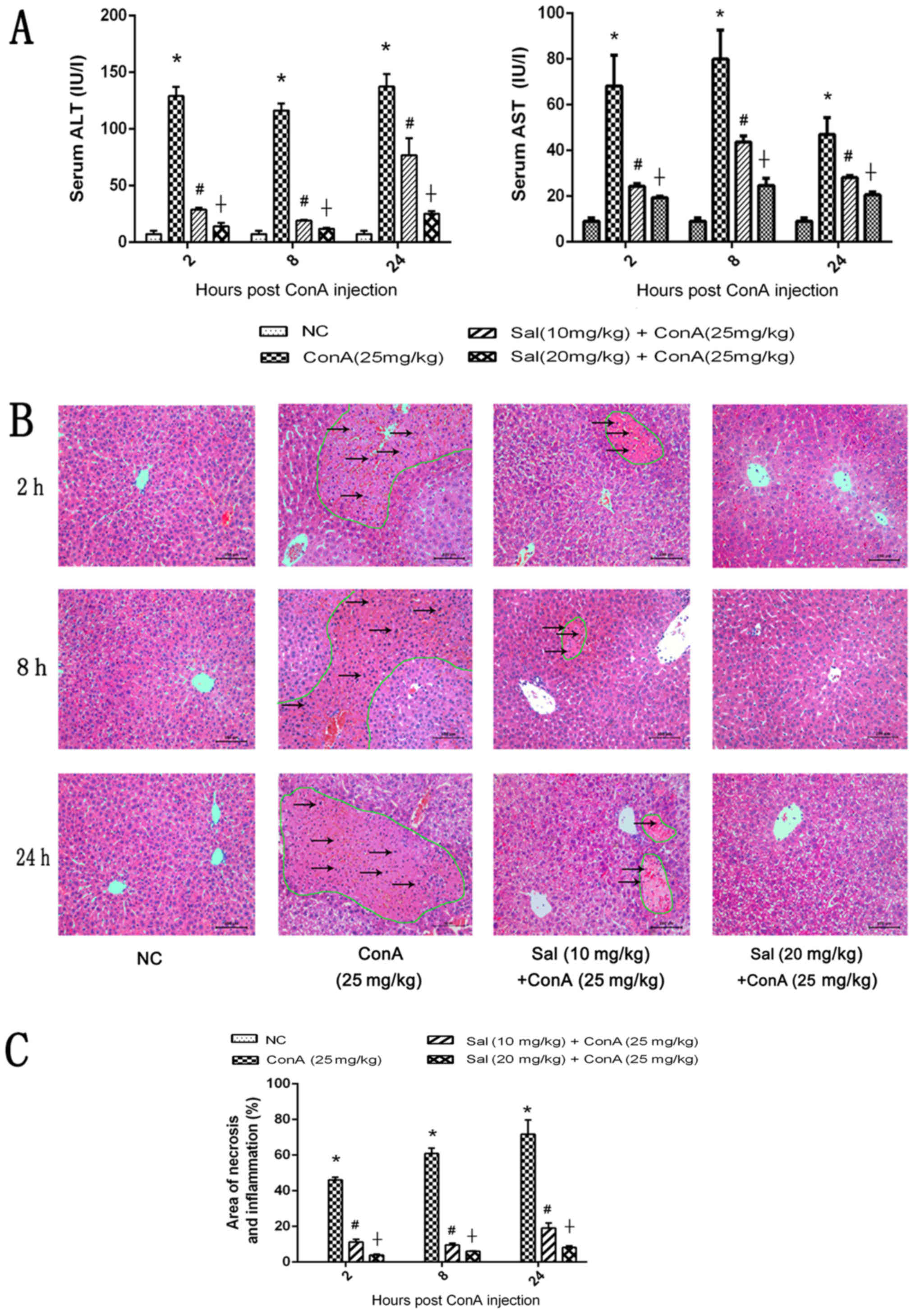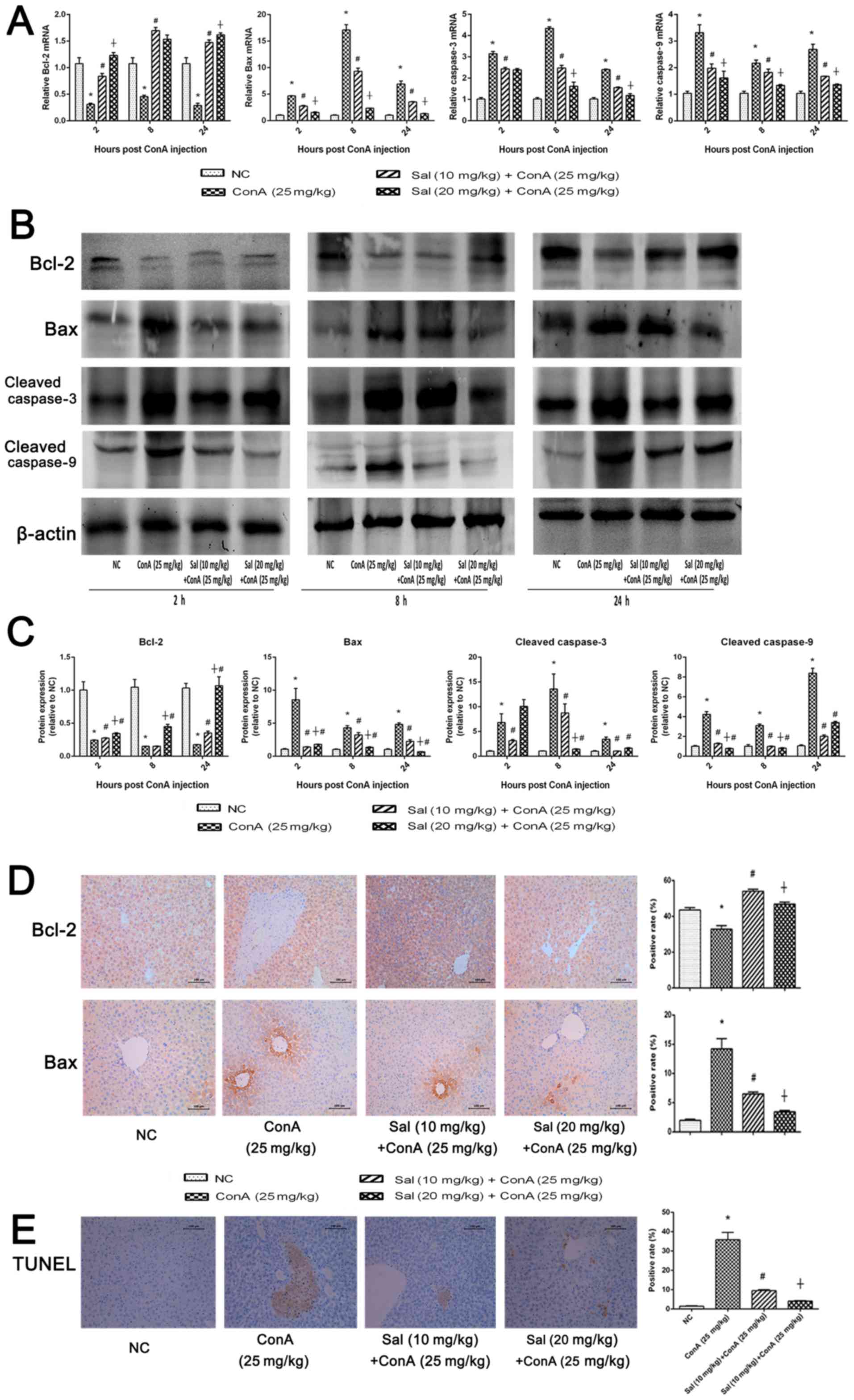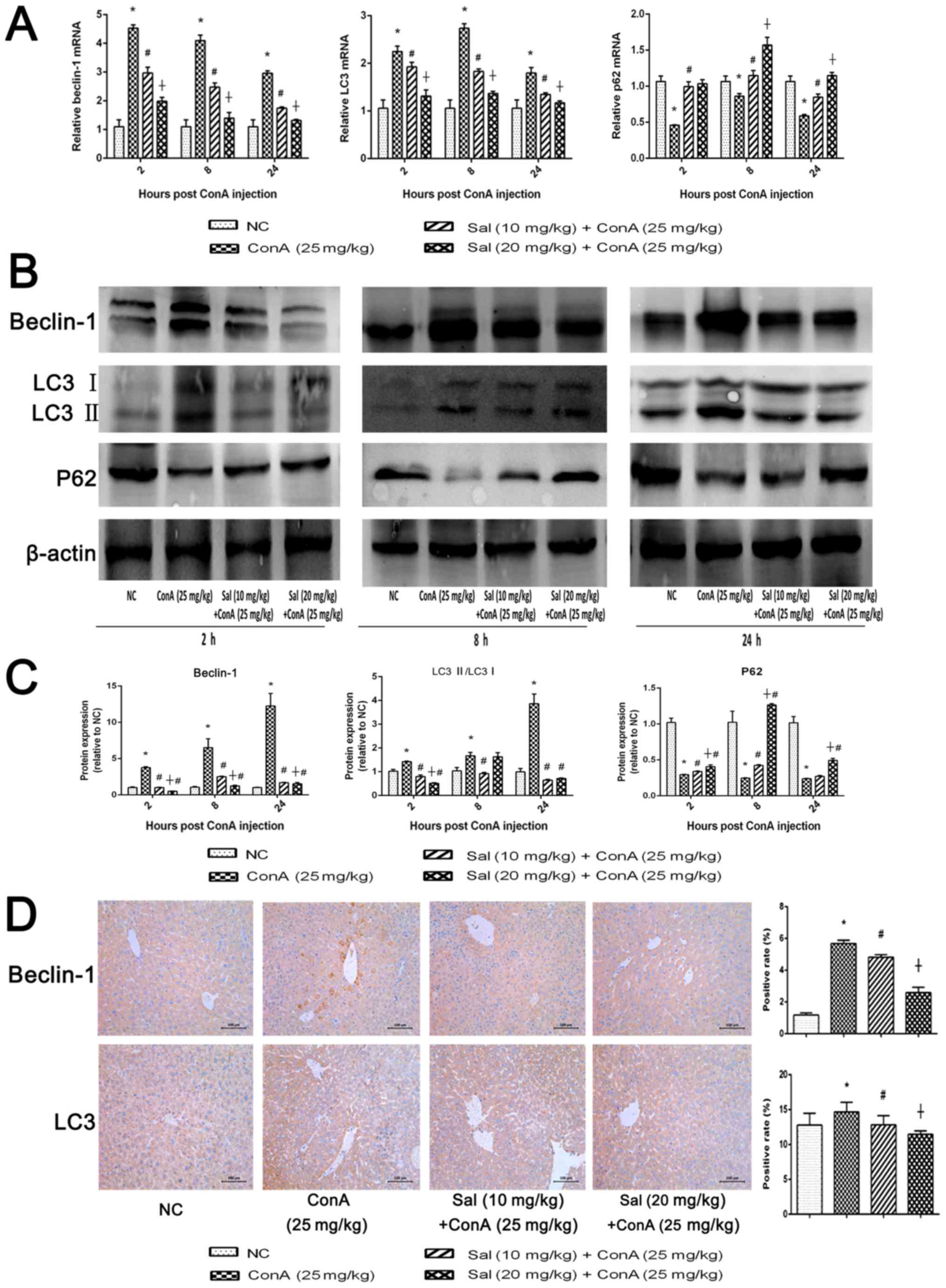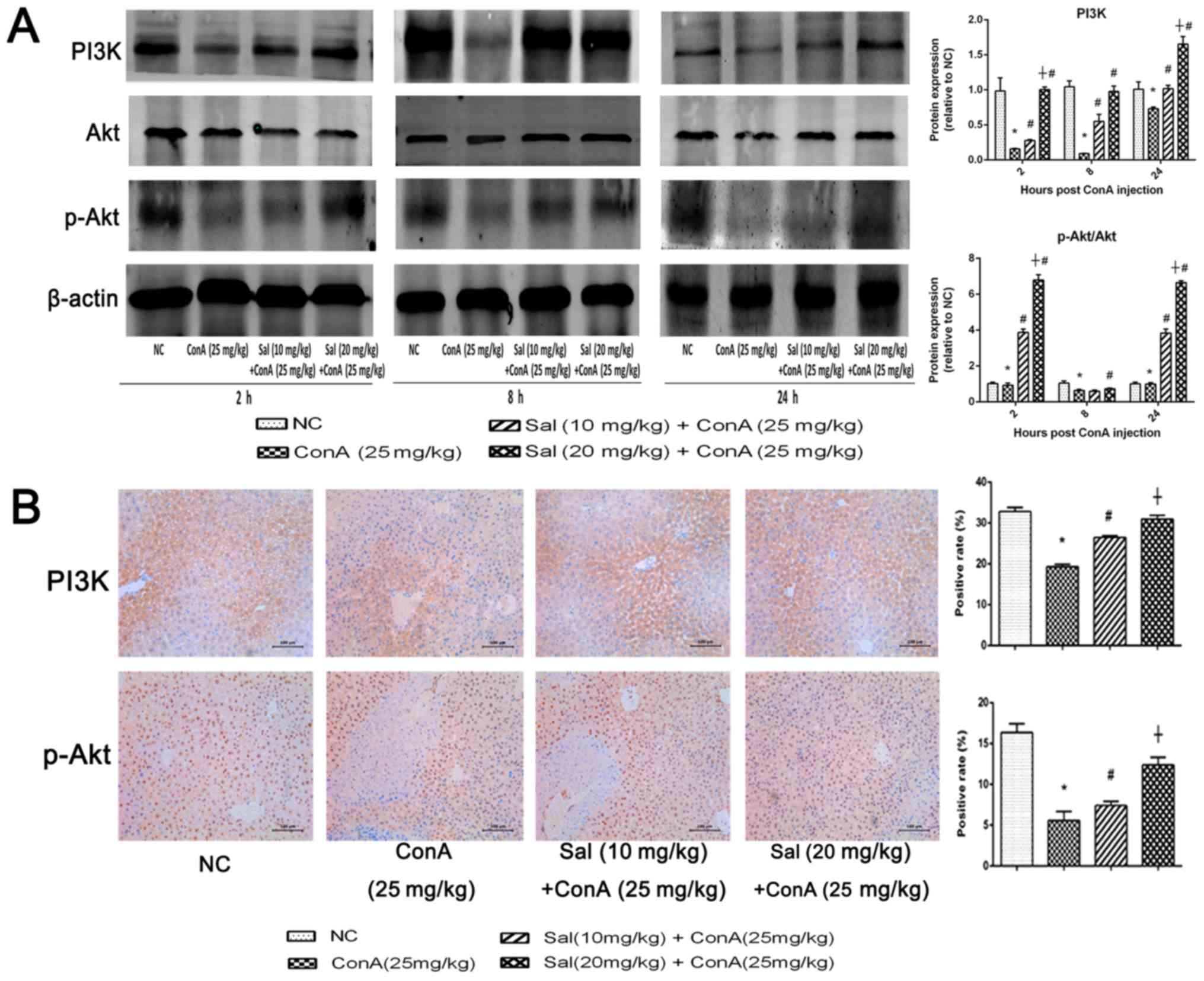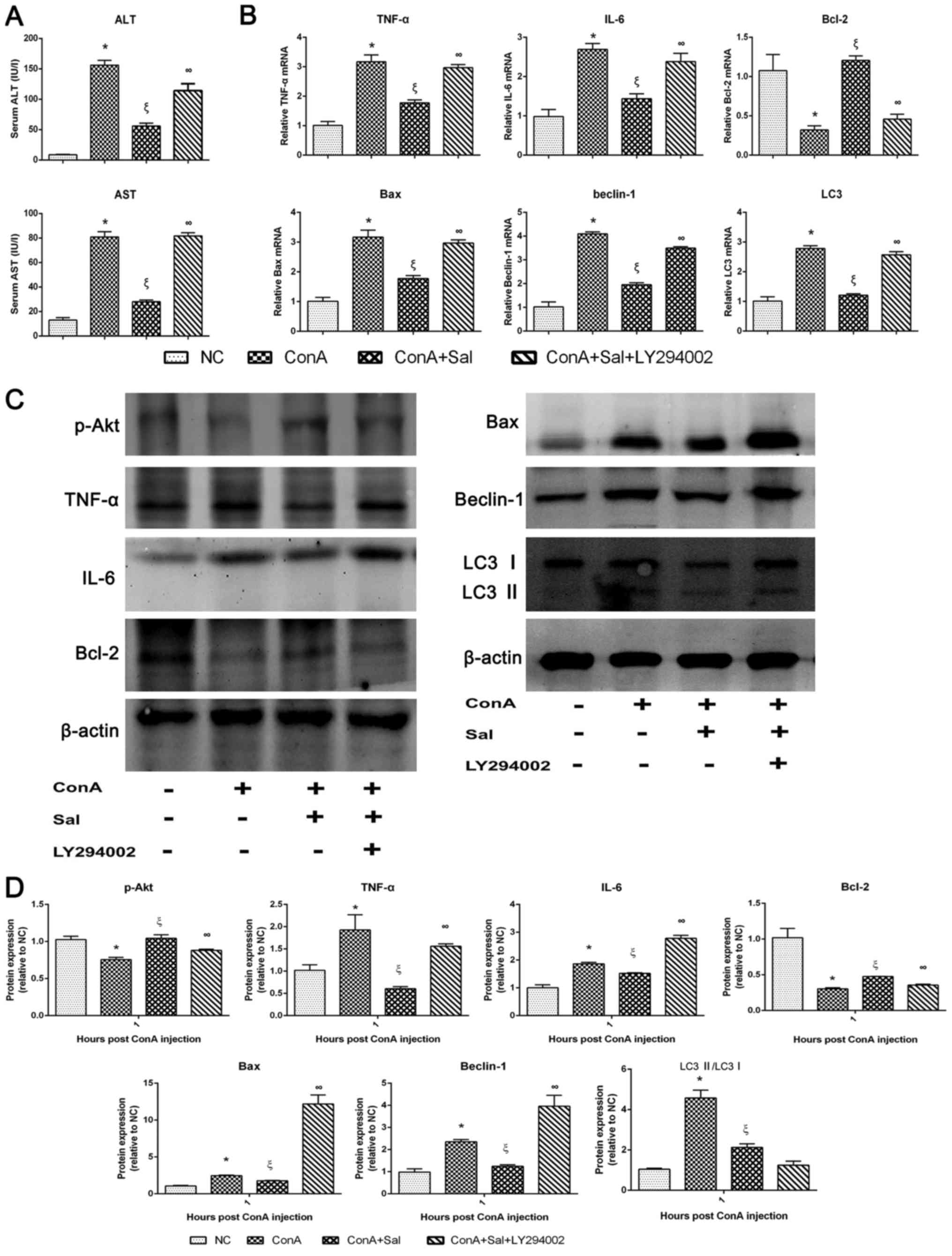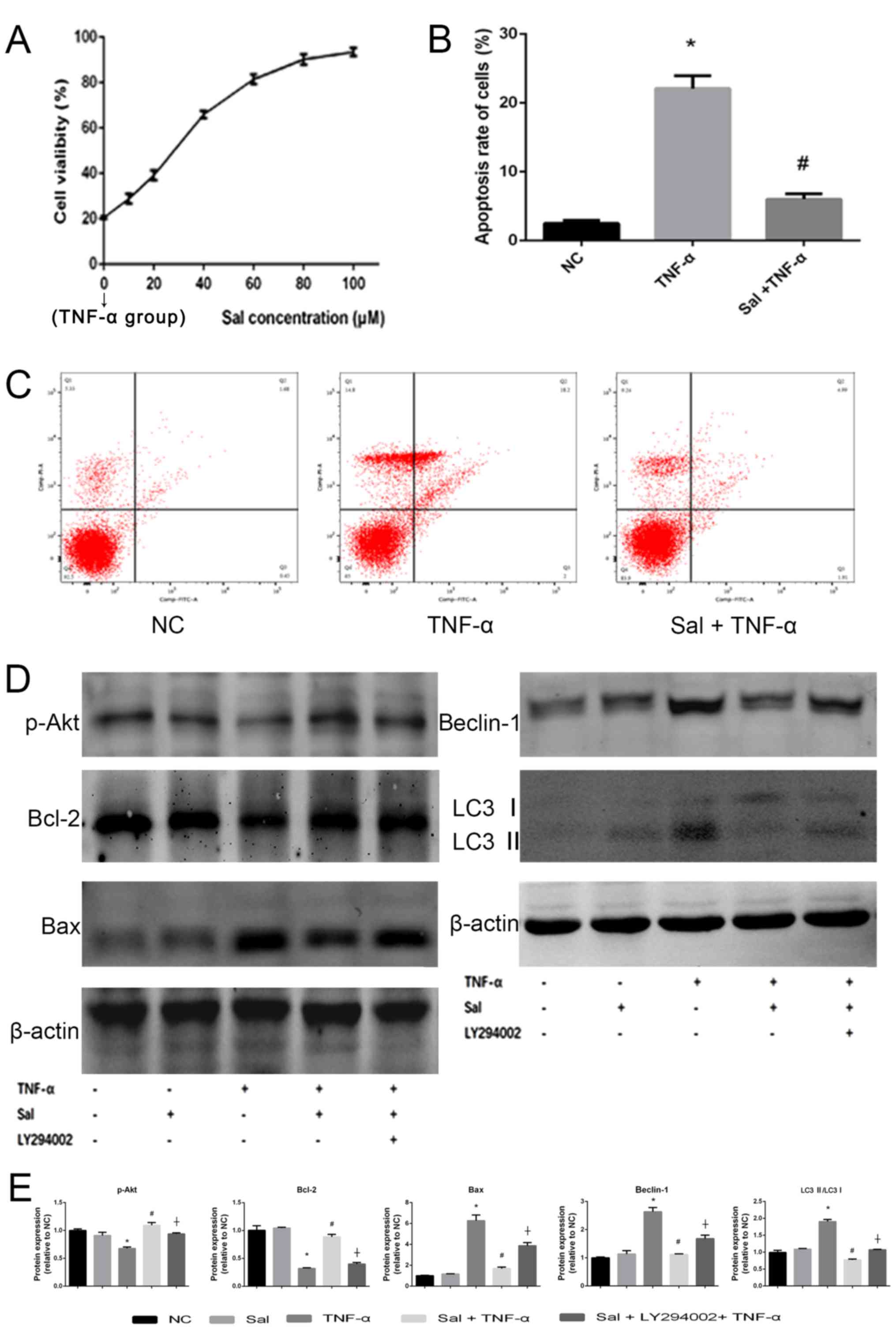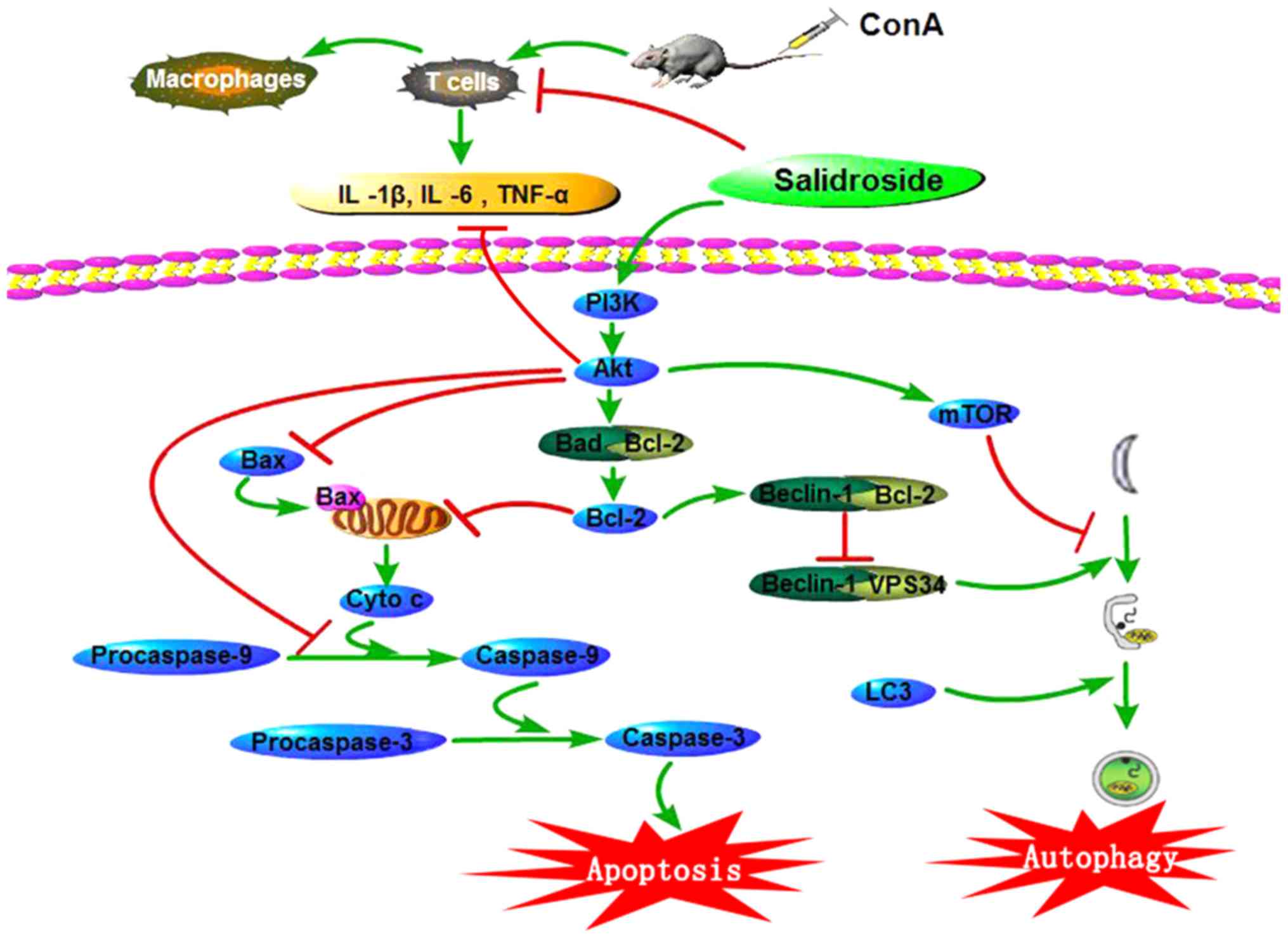|
1
|
Than NN, Jeffery HC and Oo YH: Autoimmune
hepatitis: Progress from global immunosuppression to personalised
regulatory T cell therapy. Can J Gastroenterol Hepatol.
2016:71816852016.PubMed/NCBI
|
|
2
|
Liberal R, Grant CR, Mieli-Vergani G and
Vergani D: Autoimmune hepatitis: A comprehensive review. J
Autoimmun. 41:126–139. 2013. View Article : Google Scholar : PubMed/NCBI
|
|
3
|
Heneghan MA, Yeoman AD, Verma S, Smith AD
and Longhi MS: Autoimmune hepatitis. Lancet. 382:1433–1444. 2013.
View Article : Google Scholar : PubMed/NCBI
|
|
4
|
Liberal R, Grant CR, Longhi MS,
Mieli-Vergani G and Vergani D: Diagnostic criteria of autoimmune
hepatitis. Autoimmun Rev. 13:435–440. 2014. View Article : Google Scholar : PubMed/NCBI
|
|
5
|
Tiegs G, Hentschel J and Wendel A: A T
cell-dependent experimental liver injury in mice inducible by
concanavalin A. J Clin Invest. 90:196–203. 1992. View Article : Google Scholar : PubMed/NCBI
|
|
6
|
Heymann F, Hamesch K, Weiskirchen R and
Tacke F: The concanavalin A model of acute hepatitis in mice. Lab
Anim. 49 1 Suppl:S12–S20. 2015. View Article : Google Scholar
|
|
7
|
Bies C, Lehr CM and Woodley JF:
Lectin-mediated drug targeting: History and applications. Adv Drug
Deliv Rev. 56:425–435. 2004. View Article : Google Scholar : PubMed/NCBI
|
|
8
|
Varthaman A, Khallou-Laschet J, Clement M,
Fornasa G, Kim HJ, Gaston AT, Dussiot M, Caligiuri G, Herbelin A,
Kaveri S, et al: Control of T cell reactivation by regulatory
Qa-1-restricted CD8+ T cells. J Immunol. 184:6585–6591. 2010.
View Article : Google Scholar : PubMed/NCBI
|
|
9
|
Yin XM, Ding WX and Gao W: Autophagy in
the liver. Hepatology. 47:1773–1785. 2008. View Article : Google Scholar : PubMed/NCBI
|
|
10
|
Mao Y, Wang J, Yu F, Cheng J, Li H, Guo C
and Fan X: Ghrelin reduces liver impairment in a model of
concanavalin A-induced acute hepatitis in mice. Drug Des Devel
Ther. 9:5385–5396. 2015. View Article : Google Scholar : PubMed/NCBI
|
|
11
|
Li S, Xia Y, Chen K, Li J, Liu T, Wang F,
Lu J, Zhou Y and Guo C: Epigallocatechin-3-gallate attenuates
apoptosis and autophagy in concanavalin A-induced hepatitis by
inhibiting BNIP3. Drug Des Devel Ther. 10:631–647. 2016. View Article : Google Scholar : PubMed/NCBI
|
|
12
|
Liu T, Xia Y, Li J, Li S, Feng J, Wu L,
Zhang R, Xu S, Cheng K, Zhou Y, et al: Shikonin attenuates
concanavalin A-induced acute liver injury in mice via inhibition of
the JNK pathway. Mediators Inflamm. 2016:27483672016. View Article : Google Scholar : PubMed/NCBI
|
|
13
|
Li J, Chen K, Li S, Liu T, Wang F, Xia Y,
Lu J, Zhou Y and Guo C: Pretreatment with fucoidan from fucus
vesiculosus protected against ConA-induced acute liver injury by
inhibiting both intrinsic and extrinsic apoptosis. PLoS One.
11:e01525702016. View Article : Google Scholar : PubMed/NCBI
|
|
14
|
Gantner F, Leist M, Lohse AW, Germann PG
and Tiegs G: Concanavalin A-induced T-cell-mediated hepatic injury
in mice: The role of tumor necrosis factor. Hepatology. 21:190–198.
1995. View Article : Google Scholar : PubMed/NCBI
|
|
15
|
Czaja AJ: Targeting apoptosis in
autoimmune hepatitis. Dig Dis Sci. 59:2890–2904. 2014. View Article : Google Scholar : PubMed/NCBI
|
|
16
|
Portt L, Norman G, Clapp C, Greenwood M
and Greenwood MT: Anti-apoptosis and cell survival: A review.
Biochim Biophys Acta. 1813:238–259. 2011. View Article : Google Scholar : PubMed/NCBI
|
|
17
|
Gordy C and He YW: The crosstalk between
autophagy and apoptosis: Where does this lead? Protein Cell.
3:17–27. 2012. View Article : Google Scholar : PubMed/NCBI
|
|
18
|
Pyo JO, Jang MH, Kwon YK, Lee HJ, Jun JI,
Woo HN, Cho DH, Choi B, Lee H, Kim JH, et al: Essential roles of
Atg5 and FADD in autophagic cell death: Dissection of autophagic
cell death into vacuole formation and cell death. J Biol Chem.
280:20722–20729. 2005. View Article : Google Scholar : PubMed/NCBI
|
|
19
|
Hu B, Zou Y, Liu S, Wang J, Zhu J, Li J,
Bo L and Deng X: Salidroside attenuates concanavalin A-induced
hepatitis via modulating cytokines secretion and lymphocyte
migration in mice. Mediators Inflamm. 2014:3140812014. View Article : Google Scholar : PubMed/NCBI
|
|
20
|
Palmeri A, Mammana L, Tropea MR, Gulisano
W and Puzzo D: Salidroside, a bioactive compound of rhodiola rosea,
ameliorates memory and emotional behavior in adult mice. J
Alzheimers Dis. 52:65–75. 2016. View Article : Google Scholar : PubMed/NCBI
|
|
21
|
Zou H, Liu X, Han T, Hu D, Wang Y, Yuan Y,
Gu J, Bian J, Zhu J and Liu ZP: Salidroside protects against
cadmium-induced hepatotoxicity in rats via GJIC and MAPK pathways.
PLoS One. 10:e01297882015. View Article : Google Scholar : PubMed/NCBI
|
|
22
|
Wu YL, Piao DM, Han XH and Nan JX:
Protective effects of salidroside against acetaminophen-induced
toxicity in mice. Biol Pharm Bull. 31:1523–1529. 2008. View Article : Google Scholar : PubMed/NCBI
|
|
23
|
Zhu Y, Shi YP, Wu D, Ji YJ, Wang X, Chen
HL, Wu SS, Huang DJ and Jiang W: Salidroside protects against
hydrogen peroxide-induced injury in cardiac H9c2 cells via PI3K-Akt
dependent pathway. DNA Cell Biol. 30:809–819. 2011. View Article : Google Scholar : PubMed/NCBI
|
|
24
|
Tan CB, Gao M, Xu WR, Yang XY, Zhu XM and
Du GH: Protective effects of salidroside on endothelial cell
apoptosis induced by cobalt chloride. Biol Pharm Bull.
32:1359–1363. 2009. View Article : Google Scholar : PubMed/NCBI
|
|
25
|
Hu X, Lin S, Yu D, Qiu S, Zhang X and Mei
R: A preliminary study: The anti-proliferation effect of
salidroside on different human cancer cell lines. Cell Biol
Toxicol. 26:499–507. 2010. View Article : Google Scholar : PubMed/NCBI
|
|
26
|
Chen SF, Tsai HJ, Hung TH, Chen CC, Lee
CY, Wu CH, Wang PY and Liao NC: Salidroside improves behavioral and
histological outcomes and reduces apoptosis via PI3K/Akt signaling
after experimental traumatic brain injury. PLoS One. 7:e457632012.
View Article : Google Scholar : PubMed/NCBI
|
|
27
|
Yang ZR, Wang HF, Zuo TC, Guan LL and Dai
N: Salidroside alleviates oxidative stress in the liver with
non-alcoholic steatohepatitis in rats. BMC Pharmacol Toxicol.
17:162016. View Article : Google Scholar : PubMed/NCBI
|
|
28
|
Guide for the care and use of laboratory
animals. th (ed). Washington (DC): 2011, PubMed/NCBI
|
|
29
|
McGrath JC, Drummond GB, McLachlan EM,
Kilkenny C and Wainwright CL: Guidelines for reporting experiments
involving animals: The ARRIVE guidelines. Br J Pharmacol.
160:1573–1576. 2010. View Article : Google Scholar : PubMed/NCBI
|
|
30
|
Zhang Y, Li L, Lin L, Liu J, Zhang Z, Xu D
and Xiang F: Pharmacokinetics, tissue distribution, and excretion
of salidroside in rats. Planta Med. 79:1429–1433. 2013. View Article : Google Scholar : PubMed/NCBI
|
|
31
|
Perfumi M and Mattioli L: Adaptogenic and
central nervous system effects of single doses of 3% rosavin and 1%
salidroside Rhodiola rosea L. extract in mice. Phytother Res.
21:37–43. 2007. View Article : Google Scholar : PubMed/NCBI
|
|
32
|
Feng J, Zhang Q, Mo W, Wu L, Li S, Li J,
Liu T, Xu S, Fan X and Guo C: Salidroside pretreatment attenuates
apoptosis and autophagy during hepatic ischemia-reperfusion injury
by inhibiting the mitogen-activated protein kinase pathway in mice.
Drug Des Devel Ther. 11:1989–2006. 2017. View Article : Google Scholar : PubMed/NCBI
|
|
33
|
Wu L, Zhang Q, Dai W, Li S, Feng J, Li J,
Liu T, Xu S, Wang W, Lu X, et al: Quercetin pretreatment attenuates
hepatic ischemia reperfusion-induced apoptosis and autophagy by
inhibiting ERK/NF-κB pathway. Gastroenterol Res Pract.
2017:97242172017. View Article : Google Scholar : PubMed/NCBI
|
|
34
|
Yang JC, Wu SC, Rau CS, Lu TH, Wu YC, Chen
YC, Lin MW, Tzeng SL, Wu CJ and Hsieh CH: Inhibition of the
phosphoinositide 3-kinase pathway decreases innate resistance to
lipopolysaccharide toxicity in TLR4 deficient mice. J Biomed Sci.
21:202014. View Article : Google Scholar : PubMed/NCBI
|
|
35
|
Livak KJ and Schmittgen TD: Analysis of
relative gene expression data using real-time quantitative PCR and
the 2(-Delta Delta C(T)) method. Methods. 25:402–408. 2001.
View Article : Google Scholar : PubMed/NCBI
|
|
36
|
Li J, Xia Y, Liu T, Wang J, Dai W, Wang F,
Zheng Y, Chen K, Li S, Abudumijiti H, et al: Protective effects of
astaxanthin on ConA-induced autoimmune hepatitis by the JNK/p-JNK
pathway-mediated inhibition of autophagy and apoptosis. PLoS One.
10:e01204402015. View Article : Google Scholar : PubMed/NCBI
|
|
37
|
Cheng P, Wang F, Chen K, Shen M, Dai W, Xu
L, Zhang Y, Wang C, Li J, Yang J, et al: Hydrogen sulfide
ameliorates ischemia/reperfusion-induced hepatitis by inhibiting
apoptosis and autophagy pathways. Mediators Inflamm.
2014:9352512014. View Article : Google Scholar : PubMed/NCBI
|
|
38
|
Li Z, Gao L, Tang H, Yin Y, Xiang X, Li Y,
Zhao J, Mulholland M and Zhang W: Peripheral effects of nesfatin-1
on glucose homeostasis. PloS One. 8:e715132013. View Article : Google Scholar : PubMed/NCBI
|
|
39
|
Lv C, Huang Y, Liu ZX, Yu D and Bai ZM:
Salidroside reduces renal cell carcinoma proliferation by
inhibiting JAK2/STAT3 signaling. Cancer Biomark. 17:41–47. 2016.
View Article : Google Scholar : PubMed/NCBI
|
|
40
|
Hu X, Zhang X, Qiu S, Yu D and Lin S:
Salidroside induces cell-cycle arrest and apoptosis in human breast
cancer cells. Biochem Biophys Res Commun. 398:62–67. 2010.
View Article : Google Scholar : PubMed/NCBI
|
|
41
|
Mukhopadhyay S, Panda PK, Sinha N, Das DN
and Bhutia SK: Autophagy and apoptosis: where do they meet?
Apoptosis. 19:555–566. 2014. View Article : Google Scholar : PubMed/NCBI
|
|
42
|
Clark JM, Brancati FL and Diehl AM: The
prevalence and etiology of elevated aminotransferase levels in the
United States. Am J Gastroenterol. 98:960–967. 2003. View Article : Google Scholar : PubMed/NCBI
|
|
43
|
Wang C, Xia Y, Zheng Y, Dai W, Wang F,
Chen K, Li J, Li S, Zhu R, Yang J, et al: Protective effects of
N-acetylcysteine in concanavalin A-induced hepatitis in mice.
Mediators Inflamm. 2015:1897852015. View Article : Google Scholar : PubMed/NCBI
|
|
44
|
Zhou Y, Chen K, He L, Xia Y, Dai W, Wang
F, Li J, Li S, Liu T, Zheng Y, et al: The protective effect of
resveratrol on Concanavalin-A-induced acute hepatic injury in mice.
Gastroenterol Res Pract. 2015:5063902015. View Article : Google Scholar : PubMed/NCBI
|
|
45
|
Wang HX, Liu M, Weng SY, Li JJ, Xie C, He
HL, Guan W, Yuan YS and Gao J: Immune mechanisms of Concanavalin A
model of autoimmune hepatitis. World J Gastroenterol. 18:119–125.
2012. View Article : Google Scholar : PubMed/NCBI
|
|
46
|
Zhang B, Wang Y, Li H, Xiong R, Zhao Z,
Chu X, Li Q, Sun S and Chen S: Neuroprotective effects of
salidroside through PI3K/Akt pathway activation in Alzheimer's
disease models. Drug Des Devel Ther. 10:1335–1343. 2016.PubMed/NCBI
|
|
47
|
Fan XJ, Wang Y, Wang L and Zhu M:
Salidroside induces apoptosis and autophagy in human colorectal
cancer cells through inhibition of PI3K/Akt/mTOR pathway. Oncol
Rep. 36:3559–3567. 2016. View Article : Google Scholar : PubMed/NCBI
|
|
48
|
Hu L, Zaloudek C, Mills GB, Gray J and
Jaffe RB: In vivo and in vitro ovarian carcinoma growth inhibition
by a phosphatidylinositol 3-kinase inhibitor (LY294002). Clin
Cancer Res. 6:880–886. 2000.PubMed/NCBI
|
|
49
|
Henshall DC, Araki T, Schindler CK, Lan
JQ, Tiekoter KL, Taki W and Simon RP: Activation of
Bcl-2-associated death protein and counter-response of Akt within
cell populations during seizure-induced neuronal death. J Neurosci.
22:8458–8465. 2002. View Article : Google Scholar : PubMed/NCBI
|
|
50
|
Hart JR and Vogt PK: Phosphorylation of
AKT: A mutational analysis. Oncotarget. 2:467–476. 2011. View Article : Google Scholar : PubMed/NCBI
|
|
51
|
Xu S, Wu L, Zhang Q, Feng J, Li S, Li J,
Liu T, Mo W, Wang W, Lu X, et al: Pretreatment with propylene
glycol alginate sodium sulfate ameliorated concanavalin A-induced
liver injury by regulating the PI3K/Akt pathway in mice. Life Sci.
185:103–113. 2017. View Article : Google Scholar : PubMed/NCBI
|
|
52
|
Gibson EM, Henson ES, Haney N, Villanueva
J and Gibson SB: Epidermal growth factor protects
epithelial-derived cells from tumor necrosis factor-related
apoptosis-inducing ligand-induced apoptosis by inhibiting
cytochrome c release. Cancer Res. 62:488–496. 2002.PubMed/NCBI
|
|
53
|
Cardone MH, Roy N, Stennicke HR, Salvesen
GS, Franke TF, Stanbridge E, Frisch S and Reed JC: Regulation of
cell death protease caspase-9 by phosphorylation. Science.
282:1318–1321. 1998. View Article : Google Scholar : PubMed/NCBI
|
|
54
|
Liu T, Zhang Q, Mo W, Yu Q, Xu S, Li J, Li
S, Feng J, Wu L, Lu X, et al: The protective effects of shikonin on
hepatic ischemia/reperfusion injury are mediated by the activation
of the PI3K/Akt pathway. Sci Rep. 7:447852017. View Article : Google Scholar : PubMed/NCBI
|
|
55
|
Chen K, Li JJ, Li SN, Feng J, Liu T, Wang
F, Dai WQ, Xia YJ, Lu J, Zhou YQ and Guo CY:
15-Deoxy-Δ12,14-prostaglandin J2 alleviates hepatic
ischemia-reperfusion injury in mice via inducing antioxidant
response and inhibiting apoptosis and autophagy. Acta Pharmacol
Sin. 38:672–687. 2017. View Article : Google Scholar : PubMed/NCBI
|
|
56
|
Zambrano J and Yeh ES: Autophagy and
apoptotic crosstalk: Mechanism of therapeutic resistance in
HER2-positive breast cancer. Breast Cancer (Auckl). 10:13–23.
2016.PubMed/NCBI
|
|
57
|
Chen K, Li J, Li S, Feng J, Wu L, Liu T,
Zhang R, Xu S, Cheng K, Zhou Y, et al: 15d-PGJ2 alleviates
ConA-induced acute liver injury in mice by up-regulating HO-1 and
reducing hepatic cell autophagy. Biomed Pharmacother. 80:183–192.
2016. View Article : Google Scholar : PubMed/NCBI
|
|
58
|
Lei F, Chen L, Zhang ZJ and Tian GH: The
extraction technology of salidroside and application prospects from
rhodiolarosea. Beverage Indust. 19:32016.
|



